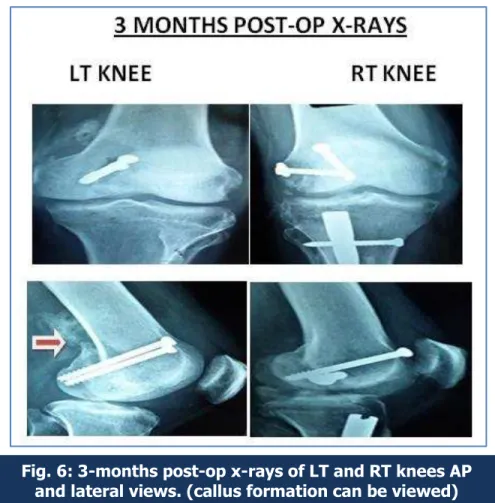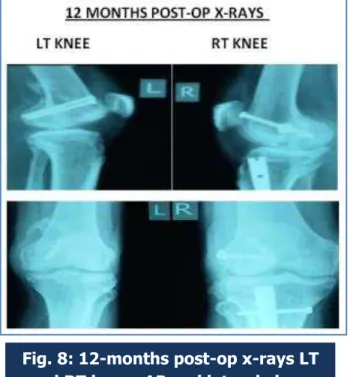CASE REPORT
J of Evidence Based Med & Hlthcare, pISSN- 2349-2562, eISSN- 2349-2570/ Vol. 2/Issue 6/Feb 09, 2015 Page 760
BILATERAL UNICONDYLAR HOFFA FRACTURE: A RARE CASE
REPORT
M. Pardha Saradhi1, S. Kishore Babu2, Sandeep Saraf3, Sasi Bushan Reddy4, K. Harish5
HOW TO CITE THIS ARTICLE:
M. Pardha Saradhi, S. Kishore Babu, Sandeep Saraf, Sasi Bushan Reddy, K. Harish. ”Bilateral Unicondylar Hoffa Fracture: A Rare Case Report”. Journal of Evidence based Medicine and Healthcare; Volume 2, Issue 6, February 9, 2015; Page: 760-768.
INTRODUCTION: Hoffa fracture was first described by FRIEDRICH BUSCH, a surgeon from Berlin in 1869, and always supposed by ALBERT HOFFA in 1904. It is a rare injury consisting of tangential (CORONAL SHEAR) fracture of distal femoral condyles. These fractures are due to high energy trauma and typically seen in a motor bike accident in a young patient subjected to shear force in both sagittal and coronal plane.(1) These fractures are not easy to visualise on routine
imaging and therefore could represent a diagnostic challenge to the accident department and orthopaedic surgeons.(2)
We have reviewed the literature and hereby reported a case of Bilateral uni-condylar hoffa fracture which is extremely rare injury.
CASE REPORT: A 40 year old male labourer presented to orthopaedic emergency with complaint of acute pain and swelling in his both knee joints following trauma. He had a fall from 10metre high ladder with direct impact on his semiflexed knees. There were associated injuries on right leg and foot. Patient was hemodynamically stable. Local examination revealed painful swollen knees with a 1cm × 1cm lacerated wound over the anterior aspect of right knee and 2cm × 1cm laceration over left knee. The range movements were restricted. There was no distal neurovascular deficit or signs of raised compartment pressure. Plain radiographs revealed fracture distal end of left femur (fig. 1a) and right femur (fig. 1b) along with fracture tibia of right leg (fig. 1c) but were inadequate to define the exact fracture pattern.
CASE REPORT
J of Evidence Based Med & Hlthcare, pISSN- 2349-2562, eISSN- 2349-2570/ Vol. 2/Issue 6/Feb 09, 2015 Page 761 Non contrast computed tomographic (CT) scan was performed which established the diagnosis of LT knee medial Hoffa displaced (fig. 2a & 2b) and RT knee lateral Hoffa undisplaced (fig. 2c & 2d).
Immediately with in 48hrs after injury, patient was operated in supine position under tourniquet control and regional anesthesia. The lacerated wound was meticulously debrided. The left knee joint was then exposed by Medial parapatellar approach (fig-3a).The rest of the extensor mechanism along with the patella was retracted laterally for unobstructed visualisation of medial femoral condyle. On exposing the left knee joint,a tangential fracture involving medial femoral condyles noted. However reduction was achieved and 2 (6.5mm) cannulated cancellous screws (fig 3c & 3d) were passed from anterior to posterior direction(fig-3b) through the non-articular part under fluoroscopy control. The wound was closed in layers.
CASE REPORT
J of Evidence Based Med & Hlthcare, pISSN- 2349-2562, eISSN- 2349-2570/ Vol. 2/Issue 6/Feb 09, 2015 Page 762 On Right side, Interlocking nail tibia was done for # tibia right leg and then percutaneous fixation (fig. 4a) of lateral condyle right femur done using single 6.5mm cannulated cancellous screw (fig. 4d). Intra-operatively avulsion of Lateral collateral ligament on right side identified, which is fixed with single 6.5mm cannulated cancellous screw (fig. 4d).
CASE REPORT
J of Evidence Based Med & Hlthcare, pISSN- 2349-2562, eISSN- 2349-2570/ Vol. 2/Issue 6/Feb 09, 2015 Page 763 Post-operatively above knee back splint with 30° of knee flexion was applied for 2weeks. After 2 weeks, intermittent knee mobilisation was started along with isometric muscle strengthening exercises. Partial weight bearing was started at 6 weeks postoperatively and full weight bearing at 3months when the fracture had united radiologically.
Fig. 4: Intra-operative photos of RT knee joint
CASE REPORT
J of Evidence Based Med & Hlthcare, pISSN- 2349-2562, eISSN- 2349-2570/ Vol. 2/Issue 6/Feb 09, 2015 Page 764
Fig. 6: 3-months post-op x-rays of LT and RT knees AP and lateral views. (callus formation can be viewed)
CASE REPORT
J of Evidence Based Med & Hlthcare, pISSN- 2349-2562, eISSN- 2349-2570/ Vol. 2/Issue 6/Feb 09, 2015 Page 765
Fig. 8: 12-months post-op x-rays LT and RT knees AP and lateral views
CASE REPORT
J of Evidence Based Med & Hlthcare, pISSN- 2349-2562, eISSN- 2349-2570/ Vol. 2/Issue 6/Feb 09, 2015 Page 766 RESULTS: The patient was followed for 12months. The fracture achieved anatomical reduction and healed clinically and radiologically in LT knee and process of consolidation in RT knee. The mean flexion degree was 100° and the mean extension degree was 2.5° on both sides. The average visual analogue scale score was 1.6 points (range 0-3). The patient was assessed as good according to the Hospital for special surgery knee score system.(3)
CASE REPORT
J of Evidence Based Med & Hlthcare, pISSN- 2349-2562, eISSN- 2349-2570/ Vol. 2/Issue 6/Feb 09, 2015 Page 767 DISCUSSON: We described a rare case of bilateral unicondylar Hoffa fracture managed by open reduction and internal fixation on LT knee Hoffa and percutaneous fixation on RT knee Hoffa with good clinical outcome at 12months of followup. CT scan not only helps in defining the exact pattern of injury but also is valuable in surgical planning. Anatomic reduction and rigid internal fixation is possible with open reduction and internal fixation comparing to percutaneous technique and allows early mobilisation and excellent long term outcome.(4)
REFERENCES:
1. Hoffa A: Lehrbuch der Frakturen und Luxationen.4th ed.Stuttgart: Ferdinand Enke-Verlag 1904, 453.
2. Lewis SL, Pozo JL, Muirhead-Allwood WFG: Coronal fractures of the lateral femoral condyle. Journal of Bone and Joint Surgery (Br) 1989, 71: 118–120.
3. Ostermann PAW, Neumann K, Ekkernkamp A, Muhr G. Long-term results of unicondylar fractures of the femur. Journal of Orthopaedics and Trauma 1994, 8 (2): 142–146.
CASE REPORT
J of Evidence Based Med & Hlthcare, pISSN- 2349-2562, eISSN- 2349-2570/ Vol. 2/Issue 6/Feb 09, 2015 Page 768 5. Shetty GM, Wang JH, Kim SK, Park JH, Park JW, Kim JG, Ahn JH Incarcerated Patellar
tendon in Hoffa fracture: an unusual cause of irreducible knee dislocation Knee Surg Sports Traumatol Arthrosc. 2007 Oct 24
6. Miyamoto R, Fornari E, Tejwani NC. Hoffa fragment associated with a femora shaft fracture. A case report J Bone Joint Surg Am. 2006 Oct; 88 (10): 2270-4.
7. Calmet J, Mellado JM, GarcíaForcada IL, Giné J. Open bicondylar Hoffa fracture associated with extensor mechanism injury. J Orthop Trauma. 2004 May-Jun; 18 (5): 323-5.
1. 8.: Ul Haq R, Modi P, Dhammi IK, Jain AK, Mishra P. Conjoint bicondylar Hoffa fracture in an adult. Indian J Orthop 2013; 47: 302-6.
AUTHORS:
1. M. Pardha Saradhi 2. S. Kishore Babu 3. Sandeep Saraf 4. Sasi Bushan Reddy 5. K. Harish
PARTICULARS OF CONTRIBUTORS:
1. Assistant Professor, Department of Orthopaedics, Andhra Medical College. 2. Assistant Professor, Department of
Orthopaedics, Andhra Medical College. 3. Post Graduate, Department of
Orthopaedics, Andhra Medical College.
4. Post Graduate, Department of
Orthopaedics, Andhra Medical College. 5. Post Graduate, Department of
Orthopaedics, Andhra Medical College.
NAME ADDRESS EMAIL ID OF THE CORRESPONDING AUTHOR:
Dr. Sandeep Saraf,
Room No. 5, P. G. Men’s Hostel,
King George Hospital, Visakhapatnam. E-mail: sarafforthepeople@gmail.com






